Green Infrastructure in the Time of Social Distancing: Urban Policy and the Tactical Pandemic Urbanism
Abstract
1. Introduction
1.1. Health Benefits of Green Infrastructure during Pandemics
1.2. Tactical Urbanism Interventions in Public and Green Space during COVID-19 Pandemic
1.3. The Structure of the Article
2. Material and Methods
2.1. Research Area
2.2. Pandemic Urban Ethnography as a Research Method
- Autoethnography.
- Individual semi-structured interviews with green infrastructure users.
- Non-participant observation.
- Digital ethnography based on social media content.
3. Results
3.1. Functional Changes
3.2. Social Media Monitoring
3.3. Declarative Use of Parks—Conclusions from the Interviews
4. Discussion
5. Conclusions
Author Contributions
Funding
Institutional Review Board Statement
Informed Consent Statement
Data Availability Statement
Conflicts of Interest
Appendix A
| Interview Scenario | |
|---|---|
| PART 1. | Introduction to the interview: self-introduction and clarification of the purpose of the conversation (a scientific study of the use of Miramar/Polińskiego Park; questions about the respondent’s needs or doubts). |
| PART 2. | Research questions:
|
| PART 3. | Thanks for the conversation and collecting any additional comments. |
References
- Szczygiel, B.; Hewitt, R. Nineteenth-century medical landscapes: John H. Rauch, Frederick Law Olmsted, and the search for salubrity. Bull. Hist. Med. 2000, 74, 708–734. [Google Scholar] [CrossRef] [PubMed]
- Klein, C. How Pandemics Spurred Cities to Make More Green Space for People. Available online: https://www.history.com/news/cholera-pandemic-new-york-city-london-paris-green-space (accessed on 16 November 2020).
- Rybczynski, W. A Clearing in the Distance: Frederick Law Olmsted and America in the 19th Century; Scribner: New York, NY, USA, 1999; ISBN 9780684824635. [Google Scholar]
- Fisher, T. Frederick Law Olmsted and the Campaign for Public Health. Places 2010. [Google Scholar] [CrossRef]
- Allam, Z.; Jones, D.S. Pandemic stricken cities on lockdown. Where are our planning and design professionals [now, then and into the future]? Land Use Policy 2020, 97, 104805. [Google Scholar] [CrossRef] [PubMed]
- Shribman, D. Revisiting an Old Treatment for Infectious Disease: Fresh Air. The Boston Globe. 2020. Available online: https://www.bostonglobe.com/2020/04/04/opinion/revisiting-an-old-treatment-infectious-disease-fresh-air/ (accessed on 1 May 2020).
- Hobday, R.A.; Cason, J.W. The open-air treatment of pandemic influenza. Am. J. Public Health 2009, 99 (Suppl. 2), S236–S242. [Google Scholar] [CrossRef] [PubMed]
- Roberts, J.D.; Tehrani, S.O. Environments, Behaviors, and Inequalities: Reflecting on the Impacts of the Influenza and Coronavirus Pandemics in the United States. Int. J. Environ. Res. Public Health 2020, 17, 4484. [Google Scholar] [CrossRef]
- Kleinschroth, F.; Kowarik, I. COVID-19 crisis demonstrates the urgent need for urban greenspaces. Front. Ecol. Environ. 2020, 18, 318–319. [Google Scholar] [CrossRef]
- Akpinar, A.; Barbosa-Leiker, C.; Brooks, K.R. Does green space matter? Exploring relationships between green space type and health indicators. Urban For. Urban Green. 2016, 20, 407–418. [Google Scholar] [CrossRef]
- Coppel, G.; Wüstemann, H. The impact of urban green space on health in Berlin, Germany: Empirical findings and implications for urban planning. Landsc. Urban Plan. 2017, 167, 410–418. [Google Scholar] [CrossRef]
- Xie, J.; Luo, S.; Furuya, K.; Sun, D. Urban Parks as Green Buffers During the COVID-19 Pandemic. Sustain. Sci. Pract. Policy 2020, 12, 6751. [Google Scholar] [CrossRef]
- Braubach, M.; Egorov, A.; Mudu, P.; Wolf, T.; Ward Thompson, C.; Martuzzi, M. Effects of Urban Green Space on Environmental Health, Equity and Resilience. In Nature-Based Solutions to Climate Change Adaptation in Urban Areas: Linkages between Science, Policy and Practice; Kabisch, N., Korn, H., Stadler, J., Bonn, A., Eds.; Springer International Publishing: Cham, Switzerland, 2017; pp. 187–205. ISBN 9783319560915. [Google Scholar]
- McCunn, L.J. The importance of nature to city living during the COVID-19 pandemic: Considerations and goals from environmental psychology. Cities Health 2020, 1–4. [Google Scholar] [CrossRef]
- Rodgers, C. Nourishing and protecting our urban “green” space in a post-pandemic world. Environ. Law Rev. 2020, 22, 165–169. [Google Scholar] [CrossRef]
- Day, B.H. The Value of Greenspace under Pandemic Lockdown. Environ. Resour. Econ. 2020, 1–25. [Google Scholar] [CrossRef] [PubMed]
- Venter, Z.S.; Barton, D.N.; Gundersen, V.; Figari, H.; Nowell, M. Urban nature in a time of crisis: Recreational use of green space increases during the COVID-19 outbreak in Oslo, Norway. Environ. Res. Lett. 2020, 15, 104075. [Google Scholar] [CrossRef]
- Sharifi, A.; Khavarian-Garmsir, A.R. The COVID-19 pandemic: Impacts on cities and major lessons for urban planning, design, and management. Sci. Total Environ. 2020, 749, 142391. [Google Scholar] [CrossRef] [PubMed]
- Honey-Roses, J.; Anguelovski, I.; Bohigas, J.; Chireh, M.; Vincent, K.; Daher, C.; Konijnendijk, C.; Litt, J.; Mawani, V.; McCall, M.; et al. The Impact of COVID-19 on Public Space: A Review of the Emerging Questions. Cities Health 2020. [Google Scholar] [CrossRef]
- Combs, T. Local Actions to Support Walking and Cycling During Social Distancing Dataset. 2020. Available online: http://pedbikeinfo.org/resources/resources_details.cfm?id=5209 (accessed on 1 October 2020).
- Herman, K.; Rodgers, M. From Tactical Urbanism Action to Institutionalised Urban Planning and Educational Tool: The Evolution of Park(ing) Day. Land 2020, 9, 217. [Google Scholar] [CrossRef]
- Tactical Urbanism as a Response during the Pandemic. Available online: https://www.metropolis.org/news/tactical-urbanism-response-during-pandemic (accessed on 26 January 2021).
- Barbarossa, L. The Post Pandemic City: Challenges and Opportunities for a Non-Motorized Urban Environment. An Overview of Italian Cases. Sustain. Sci. Pract. Policy 2020, 12, 7172. [Google Scholar] [CrossRef]
- Slater, S.J.; Christiana, R.W.; Gustat, J. Recommendations for Keeping Parks and Green Space Accessible for Mental and Physical Health during COVID-19 and Other Pandemics. Prev. Chronic Dis. 2020, 17, E59. [Google Scholar] [CrossRef]
- Reid, C. New Zealand First Country to Fund Pop-Up Bike Lanes, Widened Sidewalks During Lockdown. Forbes Magazine. Available online: https://www.forbes.com/sites/carltonreid/2020/04/13/new-zealand-firstcountry-to-fund-pop-up-bike-lanes-widened-sidewalks-during-lockdown/ (accessed on 5 May 2020).
- NZ Transport Agency Innovating Streets—All Updates | Waka Kotahi NZ Transport Agency. Available online: https://www.nzta.govt.nz/roads-and-rail/innovating-streets/ (accessed on 4 May 2020).
- Govt to Fund Temporary Cycleways and Footpaths Post COVID-19 Lockdown. Available online: https://www.beehive.govt.nz/release/govt-fund-temporary-cycleways-and-footpaths-post-covid-19-lockdown (accessed on 4 May 2020).
- Wellington. A Green Covid-19 Recovery Programme for Wellington. Available online: http://wellington.scoop.co.nz/?p=127717 (accessed on 17 November 2020).
- Kolejne kroki w walce z koronawirusem–w sklepie mniej osób, ograniczenia w poruszaniu nieletnich, a parki, plaże i bulwary zamknięte—Koronawirus: Informacje i zalecenia—Portal Gov.pl. Available online: https://www.gov.pl/web/koronawirus/kolejne-kroki (accessed on 1 December 2020).
- Miejskie parki, lasy, bulwary, plaże i zieleńce niedostępne. Available online: http://www.um.warszawa.pl/aktualnosci/miejskie-parki-bulwary-pla-e-i-ziele-ce-niedost-pne (accessed on 1 December 2020).
- Lasy i parki narodowe otwarte—Regionalna Dyrekcja Ochrony Środowiska w Gorzowie Wielkopolskim—Portal Gov.pl. Available online: https://www.gov.pl/web/rdos-gorzow-wielkopolski/lasy-i-parki-narodowe-otwarte (accessed on 1 December 2020).
- Alert Level 3 Means Stay Home and Stay Local. Available online: https://ourauckland.aucklandcouncil.govt.nz/articles/news/2020/08/alert-level-3-means-stay-home-and-stay-local/ (accessed on 1 December 2020).
- Bezpieczne chodniki. Przenosimy parkowanie na jezdnię. Available online: https://www.um.warszawa.pl/aktualnosci/bezpieczne-chodniki-przenosimy-parkowanie-na-jezdni (accessed on 1 December 2020).
- Więcej miejsca dla pieszych na placu Zbawiciela. Available online: https://www.um.warszawa.pl/aktualnosci/wi-cej-miejsca-dla-pieszych-na-placu-zbawiciela (accessed on 1 December 2020).
- Horton, R.P. Lawn Mowed into Checkerboard Becomes Natural Social Distancing Space—Urban Gardens. Available online: https://www.urbangardensweb.com/2020/06/26/lawn-mowed-into-checkerboard-becomes-natural-social-distancing-space/ (accessed on 1 December 2020).
- Elblag: Social Distancing Lawn Brings People Together. Available online: https://www.ubc.net/content/elblag-social-distancing-lawn-brings-people-together (accessed on 1 December 2020).
- Traverso, V. How Social-Distancing Symbols Are Changing Our Cities; BBC. Available online: https://www.bbc.com/worklife/article/20200909-how-social-distancing-symbols-are-changing-our-cities (accessed on 1 October 2020).
- Pillans, B.; Huber, P. New Zealand. Earthquake and War Damage Commission Earthquakes and Uplift History of Miramar Peninsula, Wellington: By Brad Pillans & Phil Huber; Report to the Earthquake & War Damage Commission; Research School of Earth Sciences Victoria University of Wellington: Wellington, New Zealand, 1992. [Google Scholar]
- Grapes, R.; Campbell, H.; Eagar, S.; Ruthven, J. A history of the geology of Wellington Peninsula, New Zealand: An analysis of nineteenth to early twentieth century observations and ideas. J. R. Soc. N. Z. 2011, 41, 167–204. [Google Scholar] [CrossRef]
- A Sneaky Peek at Miramar’s History. Available online: https://wellington.govt.nz/wellington-city/about-wellington-city/history/throwbackthursday/miramar (accessed on 10 December 2020).
- 2018 Census Place Summaries. Available online: https://www.stats.govt.nz/tools/2018-census-place-summaries/ (accessed on 10 January 2021).
- Plan of the Town of Miramar North, Wellington 1906. Alexander Turnbull Library. Available online: https://ndhadeliver.natlib.govt.nz/delivery/DeliveryManagerServlet?dps_pid=IE439969 (accessed on 1 February 2021).
- Archives Online Miramar Park. Available online: https://archivesonline.wcc.govt.nz/nodes/view/116477 (accessed on 1 February 2021).
- Sportsground Locations. Available online: https://wellington.govt.nz/recreation/sports/sportsgrounds/strategy (accessed on 12 December 2020).
- Lynch, K. The Image of the City; MIT Press: Cambridge, MA, USA, 1960; ISBN 9780262620017. [Google Scholar]
- Wybory Samorządowe 2018. Available online: https://wybory2018.pkw.gov.pl/ (accessed on 23 December 2020).
- GUS—Bank Danych Lokalnych. Available online: https://bdl.stat.gov.pl/BDL (accessed on 23 December 2020).
- Whyte, W.H. The Social Life of Small Urban Spaces. 1980. Available online: https://www.academia.edu/download/55908872/thesociallifeofsmallurbanspacesmohddanish-150407042346-conversion-gate01.pdf (accessed on 1 February 2020).
- UM. st. Warszawy, Mapa Warszawy. Available online: http://mapa.um.warszawa.pl (accessed on 9 January 2021).
- GUS Stratyfikacja dochodowa mieszkańców miast. Available online: https://stat.gov.pl/statystyki-eksperymentalne/jakosc-zycia/stratyfikacja-dochodowa-mieszkancow-miast,5,1.html?fbclid=IwAR0Lt9pYpu4tDJZwaM_syjWQWQKTje9M7NWkDaqlqdw71GL9cmM5LLVwchU (accessed on 28 January 2021).
- Stake, R.E. Qualitative Case Studies. In The Sage Handbook of Qualitative Research, 3rd ed.; SAGE Publishing: Thousand Oaks, CA, USA, 2005; Volume 3, pp. 443–466. [Google Scholar]
- Francis, M. A Case Study Method for Landscape Architecture. Landsc. J. 2001, 20, 15–29. [Google Scholar] [CrossRef]
- Duneier, M.; Kasinitz, P.; Murphy, A. The Urban Ethnography Reader; Oxford University Press: Oxford, UK, 2014; ISBN 9780199743575. [Google Scholar]
- Jackson, P. Urban Ethnography. Prog. Hum. Geogr. 1985, 9, 157–176. [Google Scholar] [CrossRef]
- Pardo, I.; Prato, G.B. Introduction: Urban Ethnography Matters—Analytical Strength, Theoretical Value and Significance to Society. In The Palgrave Handbook of Urban Ethnography; Pardo, I., Prato, G.B., Eds.; Springer International Publishing: Cham, Switzerland, 2018; pp. 1–19. ISBN 9783319642895. [Google Scholar]
- Holman Jones, S. Autoethnography. In The Blackwell Encyclopedia of Sociology; John Wiley & Sons, Ltd.: Hoboken, NJ, USA, 2007. [Google Scholar]
- Ellis, C.; Adams, T.E.; Bochner, A.P. Autoethnography: An Overview. Hist. Soz. Forsch. 2011, 36, 273–290. [Google Scholar]
- Hayes, T.A. “I Thought… I Saw… I Heard…”: The Ethical and Moral Tensions of Auto/Biographically Opportunistic Research in Public Spaces. In The Palgrave Handbook of Auto/Biography; Palgrave Macmillan: London, UK, 2020; pp. 285–303. [Google Scholar]
- Drozda, Ł. The behavioural desk research in urban space analysis as a policy tool: The case of Instagram. KSzPP 2020, 61–77. [Google Scholar] [CrossRef]
- Boy, J.D.; Uitermark, J. How to study the city on Instagram. PLoS ONE 2016, 11, e0158161. [Google Scholar] [CrossRef] [PubMed]
- Zappavigna, M. Social media photography: Construing subjectivity in Instagram images. Vis. Commun. 2016, 15, 271–292. [Google Scholar] [CrossRef]
- GUS Weekly Deaths. Available online: https://stat.gov.pl/en/topics/population/population/weekly-deaths,12,2.html (accessed on 28 January 2021).
- Leaving Your House. Available online: https://covid19.govt.nz/travel-and-the-border/travel-within-new-zealand/leaving-your-house/ (accessed on 15 January 2021).
- Playground Equipment “Must Not Be Used”: DCC. Available online: https://www.odt.co.nz/news/dunedin/dcc/playground-equipment-%E2%80%98must-not-be-used%E2%80%99-dcc (accessed on 15 January 2021).
- Facebook. Available online: https://www.facebook.com/DunedinCityCouncil/photos/a.226655984046754/2904489596263366/?type=3 (accessed on 15 January 2021).
- Sportsground Locations. Available online: https://wellington.govt.nz/recreation/sports/sportsgrounds/sportsground-locations (accessed on 12 December 2020).
- Ministry of Health. New Zealand Influenza Pandemic Plan: A Framework for Action, 2nd ed.; Ministry of Health: Wellington, New Zealand, 2017. [Google Scholar]
- World Health Organization. Others Communicating Risk in Public Health Emergencies: A WHO Guideline for Emergency Risk Communication (ERC) Policy and Practice; World Health Organization: Geneva, Switzerland, 2017. [Google Scholar]
- Grochowicz, M.; Salata-Kochanowski, P. Działania miast podczas pandemii marzec 2020. In Instytut Rozwoju Miast I Regionów: Ekspertyzy i Opracowania Badawcze Obserwatorium Polityki Miejskiej; IRMiR: Warsaw, Poland, 2020. [Google Scholar]
- Kingdon, J.W.; Stano, E. Agendas, Alternatives, and Public Policies; Little, Brown: Boston, MA, USA, 1984; Volume 45. [Google Scholar]
- Yang, K. What Can COVID-19 Tell Us About Evidence-Based Management? Am. Rev. Public Admin. 2020, 50, 706–712. [Google Scholar] [CrossRef]
- Mazzucato, M. The Value of Everything: Making and Taking in the Global Economy; Hachette: New York, NY, USA, 2018. [Google Scholar]
- Annerstedt, M.; Nielsen, B.; Maaruthaveeran, S.; Konijnendijk, C. Benefits of urban parks: A systematic review. IFPRA World 2012, 6, 10–12. [Google Scholar]
- Kruize, H.; van der Vliet, N.; Staatsen, B.; Bell, R.; Chiabai, A.; Muiños, G.; Higgins, S.; Quiroga, S.; Martinez-Juarez, P.; Aberg Yngwe, M.; et al. Urban Green Space: Creating a Triple Win for Environmental Sustainability, Health, and Health Equity through Behavior Change. Int. J. Environ. Res. Public Health 2019, 16, 4403. [Google Scholar] [CrossRef]
- Kondo, M.C.; Fluehr, J.M.; McKeon, T.; Branas, C.C. Urban Green Space and Its Impact on Human Health. Int. J. Environ. Res. Public Health 2018, 15, 445. [Google Scholar] [CrossRef]
- Twohig-Bennett, C.; Jones, A. The health benefits of the great outdoors: A systematic review and meta-analysis of greenspace exposure and health outcomes. Environ. Res. 2018, 166, 628–637. [Google Scholar] [CrossRef]
- van den Berg, M.; Wendel-Vos, W.; van Poppel, M.; Kemper, H.; van Mechelen, W.; Maas, J. Health benefits of green spaces in the living environment: A systematic review of epidemiological studies. Urban For. Urban Green 2015, 14, 806–816. [Google Scholar] [CrossRef]
- Rupprecht, C.D.D.; Byrne, J.A. Informal urban greenspace: A typology and trilingual systematic review of its role for urban residents and trends in the literature. Urban For. Urban Green 2014, 13, 597–611. [Google Scholar] [CrossRef]
- Kowarik, I. Urban wilderness: Supply, demand, and access. Urban For. Urban Green. 2018, 29, 336–347. [Google Scholar] [CrossRef]
- Sikorska, D.; Łaszkiewicz, E.; Krauze, K.; Sikorski, P. The role of informal green spaces in reducing inequalities in urban green space availability to children and seniors. Environ. Sci. Policy 2020, 108, 144–154. [Google Scholar] [CrossRef]
- Przybysz, A.; Wińska-Krysiak, M.; Małecka-Przybysz, M.; Stankiewicz-Kosyl, M.; Skwara, M.; Kłos, A.; Kowalczyk, S.; Jarocka, K.; Sikorski, P. Urban wastelands: On the frontline between air pollution sources and residential areas. Sci. Total Environ. 2020, 721, 137695. [Google Scholar] [CrossRef]
- Gawryszewska, B.J.; Wilczyńska, A.; Łepkowski, M.; Nejman, R.; Cziszewska, M. The recreational potential for wastelands as well as users’ preferences for wasteland aesthetics. Case study of Warsaw, Poland. E3S Web Conf. 2018, 45, 00018. [Google Scholar] [CrossRef]
- Nejman, R.; Łepkowski, M.; Wilczyńska, A.; Gawryszewska, B.J. The right to wild. Green urban wasteland in the context of urban planning. Urban Dev. Issues 2018, 59, 43–53. [Google Scholar] [CrossRef]
- Anna, D.; Ewa, K.-B. How to Enhance the Environmental Values of Contemporary Cemeteries in an Urban Context. Sustain. Sci. Pract. Policy 2020, 12, 2374. [Google Scholar] [CrossRef]
- Casey, R. Germany: Will Authorities Crack Down on “Corona Parties”? Available online: https://www.aljazeera.com/news/2020/3/19/germany-will-authorities-crack-down-on-corona-parties (accessed on 8 January 2021).
- Herman, K.; Sbarcea, M.; Panagopoulos, T. Creating Green Space Sustainability through Low-Budget and Upcycling Strategies. Sustain. Sci. Pract. Policy 2018, 10, 1857. [Google Scholar] [CrossRef]
- Kimic, K.; Maksymiuk, G. “Green Projects” in Participatory Budgets—Inclusive initiatives for creating city’s top quality public spaces. Warsaw case study. In Inclusive/Exclusive Cities; Ministry of Health: Skopje, Slovenia North Macedonia, 2016; ISBN 9783952397299. [Google Scholar]
- The Importance of Allotments and Gardens in the Pandemic. Available online: https://www.qcs.co.uk/coronavirus/the-importance-of-allotments-and-gardens-in-the-pandemic/ (accessed on 8 January 2021).
- Khan, M.M.; Akram, M.T.; Janke, R.; Qadri, R.W.K.; Al-Sadi, A.M.; Farooque, A.A. Urban Horticulture for Food Secure Cities through and beyond COVID-19. Sustain. Sci. Pract. Policy 2020, 12, 9592. [Google Scholar] [CrossRef]
- Polacy rzucili się na ogródki działkowe przez koronawirusa. Ceny wystrzeliły. Available online: https://spidersweb.pl/bizblog/ogrodki-dzialkowe-cena-koronawirus/ (accessed on 8 January 2021).
- Liu, L.; Zhong, Y.; Ao, S.; Wu, H. Exploring the Relevance of Green Space and Epidemic Diseases Based on Panel Data in China from 2007 to 2016. Int. J. Environ. Res. Public Health 2019, 16, 2551. [Google Scholar] [CrossRef]
- Surico, J. The Power of Parks in a Pandemic. Bloom. News 2020. Available online: https://www.bloomberg.com/news/articles/2020-04-09/in-a-pandemic-the-parks-are-keeping-us-alive (accessed on 1 February 2021).
- Sturiale, L.; Scuderi, A. The Role of Green Infrastructures in Urban Planning for Climate Change Adaptation. Climate 2019, 7, 119. [Google Scholar] [CrossRef]
- Lovell, S.T.; Taylor, J.R. Supplying urban ecosystem services through multifunctional green infrastructure in the United States. Landsc. Ecol. 2013, 28, 1447–1463. [Google Scholar] [CrossRef]
- Cole, H.V.S.; Triguero-Mas, M.; Connolly, J.J.T.; Anguelovski, I. Determining the health benefits of green space: Does gentrification matter? Health Place 2019, 57, 1–11. [Google Scholar] [CrossRef] [PubMed]
- Wolch, J.R.; Byrne, J.; Newell, J.P. Urban green space, public health, and environmental justice: The challenge of making cities “just green enough”. Landsc. Urban Plan. 2014, 125, 234–244. [Google Scholar] [CrossRef]
- Parks and Outdoor Spaces: How Did the Number of Visitors Change Since the Beginning of the Pandemic? Available online: https://ourworldindata.org/grapher/change-visitors-parks-covid?tab=chart&stackMode=absolute&time=earliest..2020-07-31&country=AUS~BRA~FRA~DEU~ITA~NZL~POL~ESP~GBR~ZAF®ion=World (accessed on 28 January 2021).
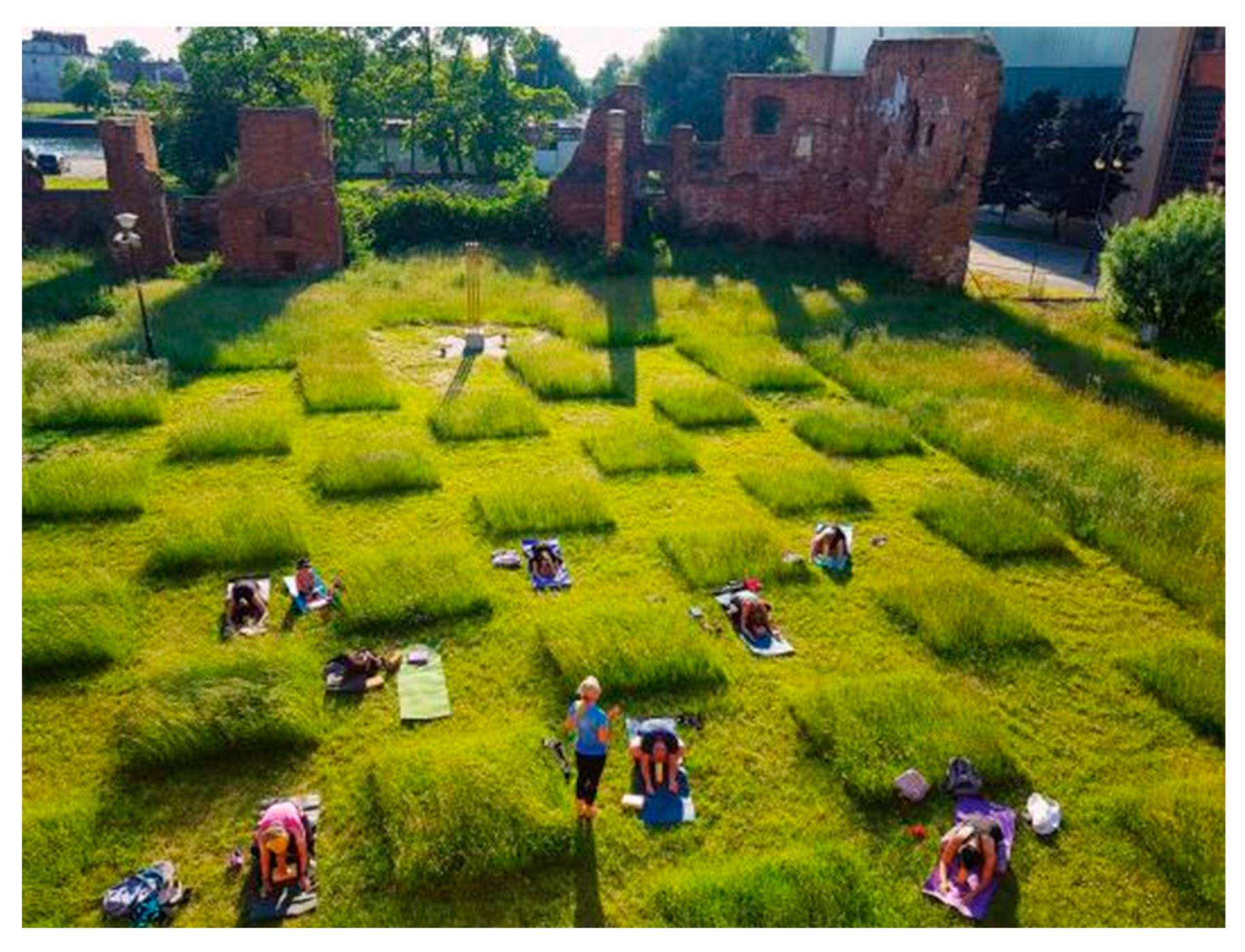
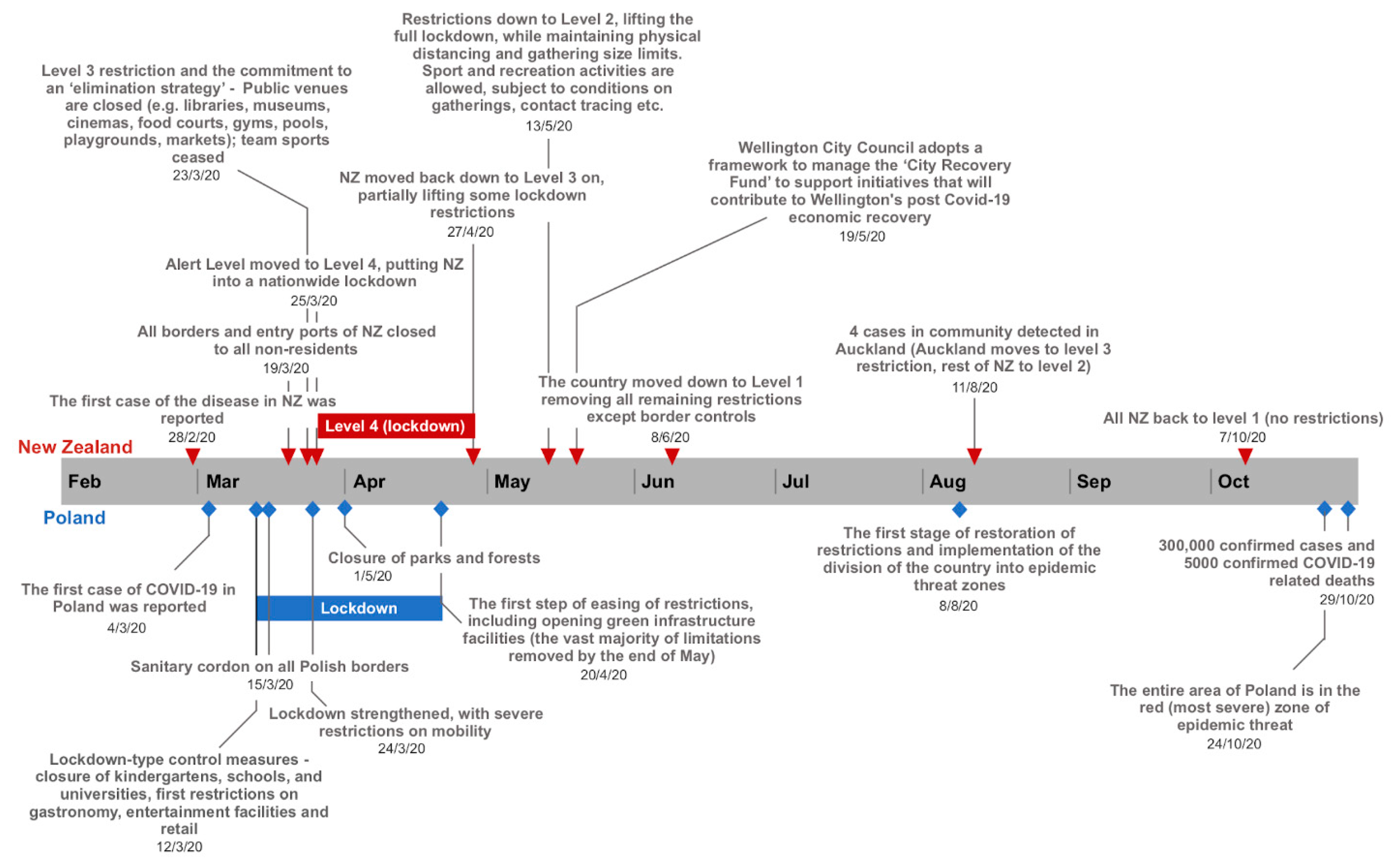
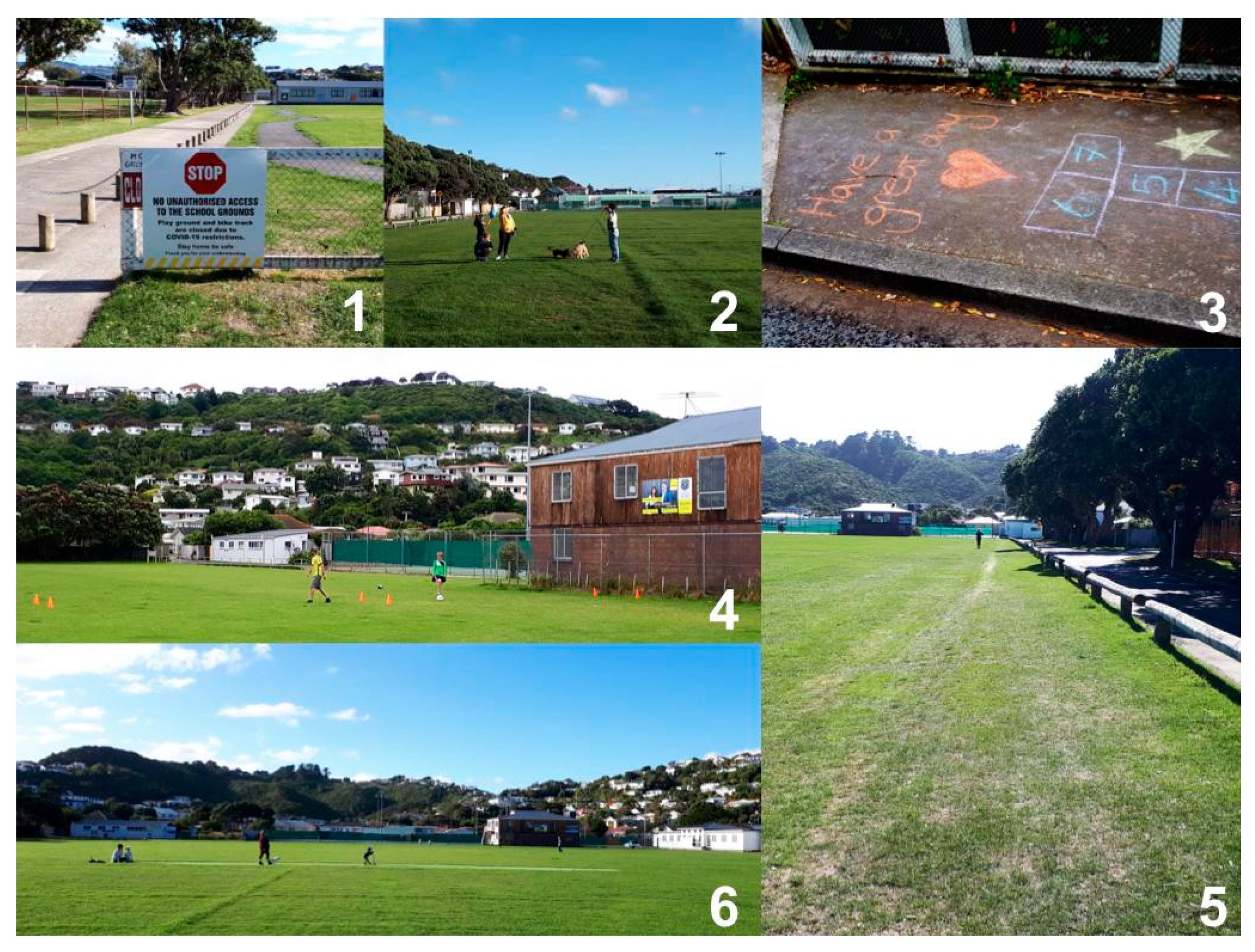
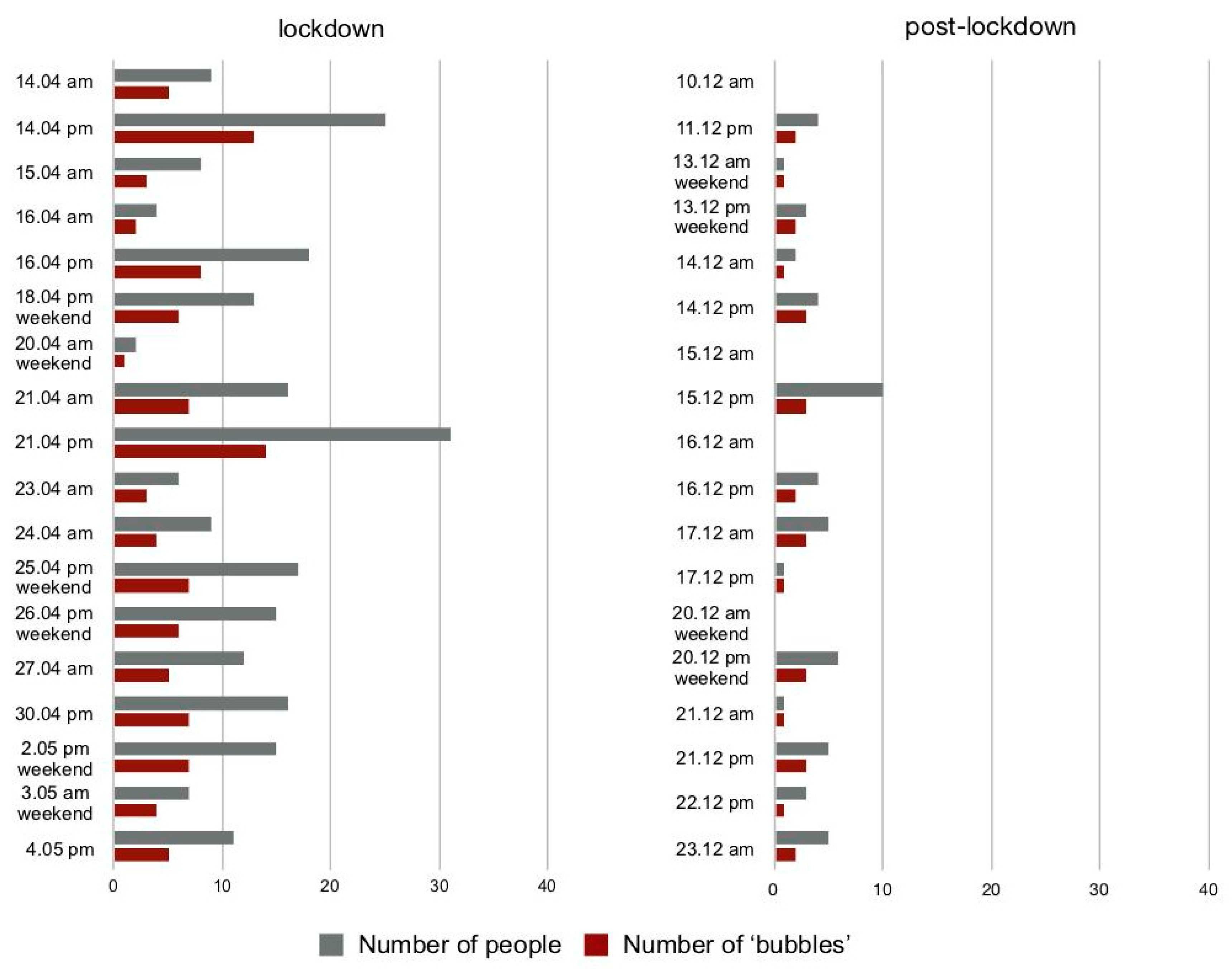
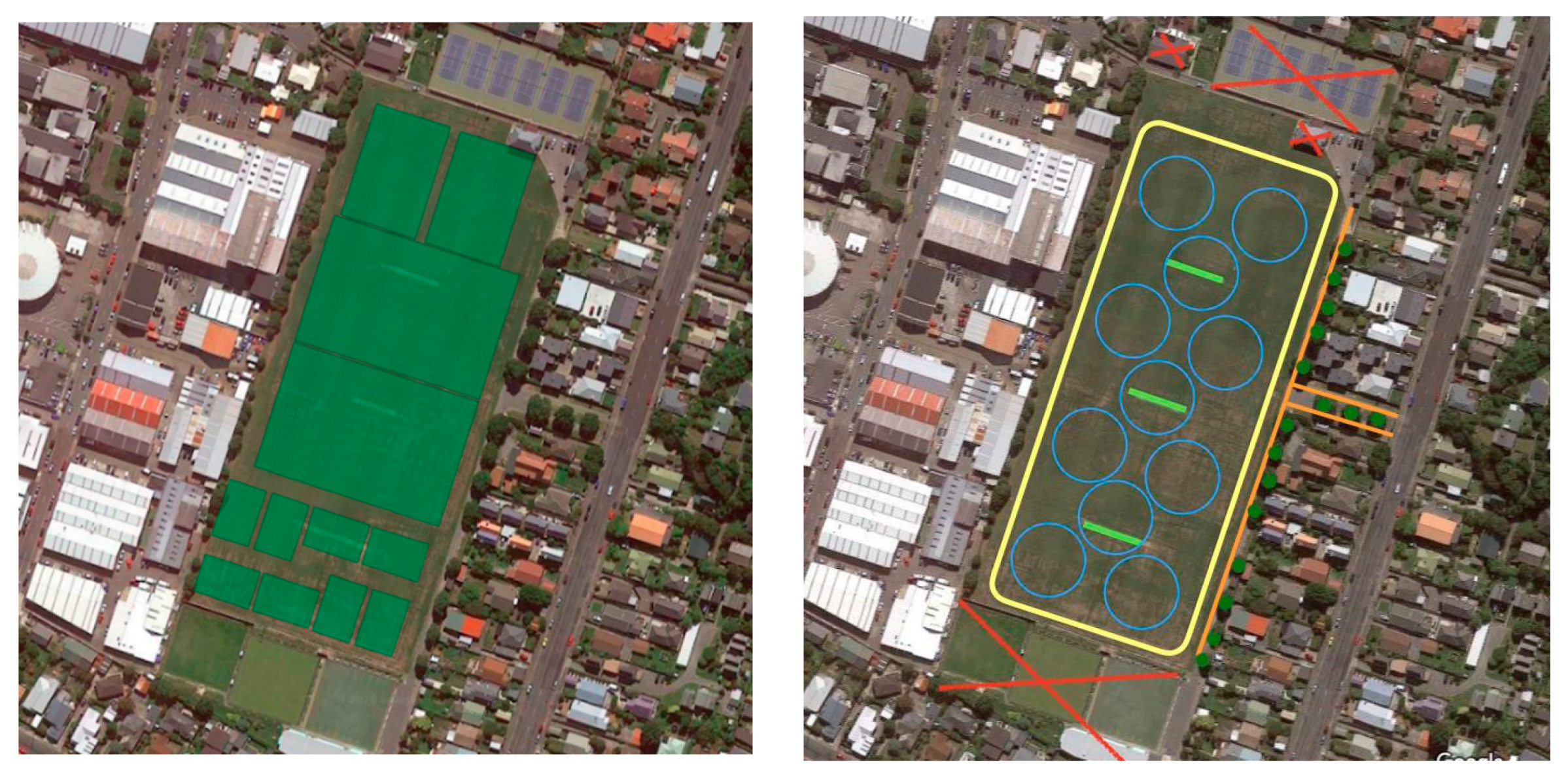

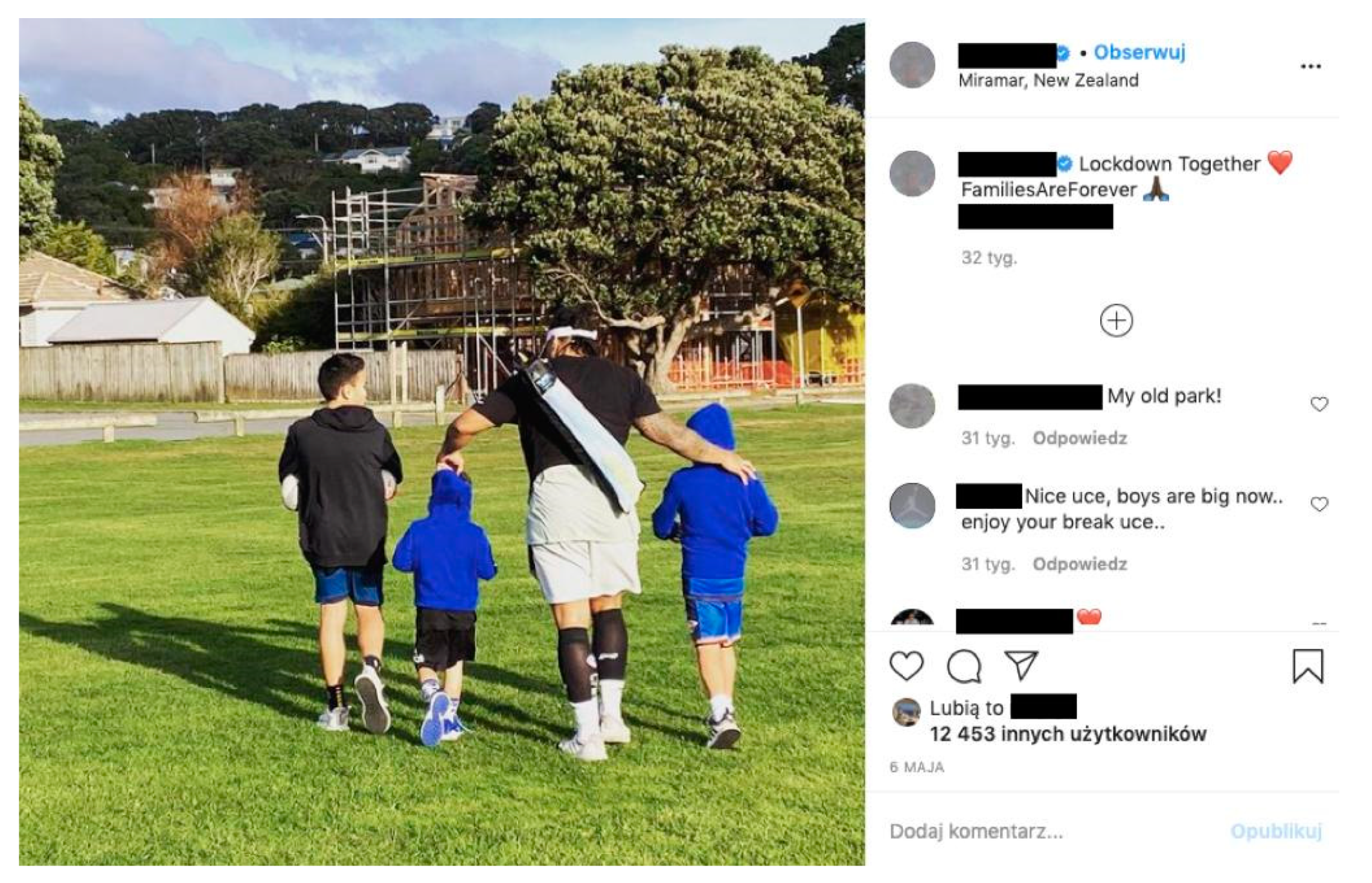
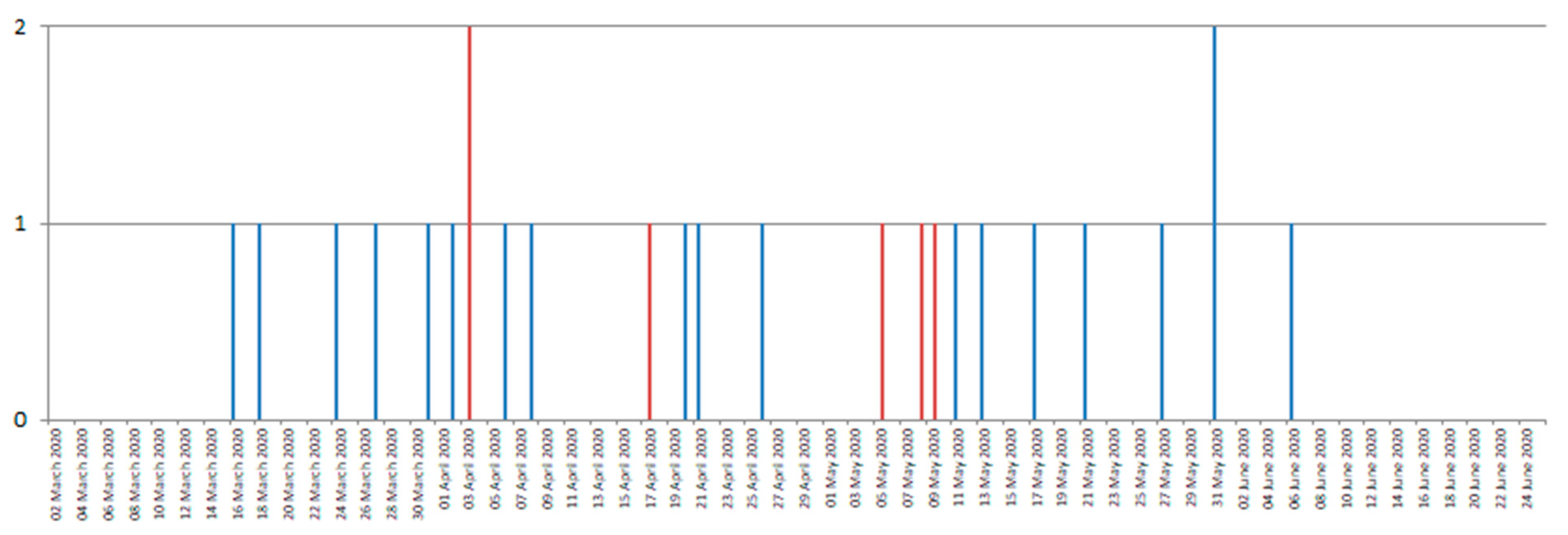
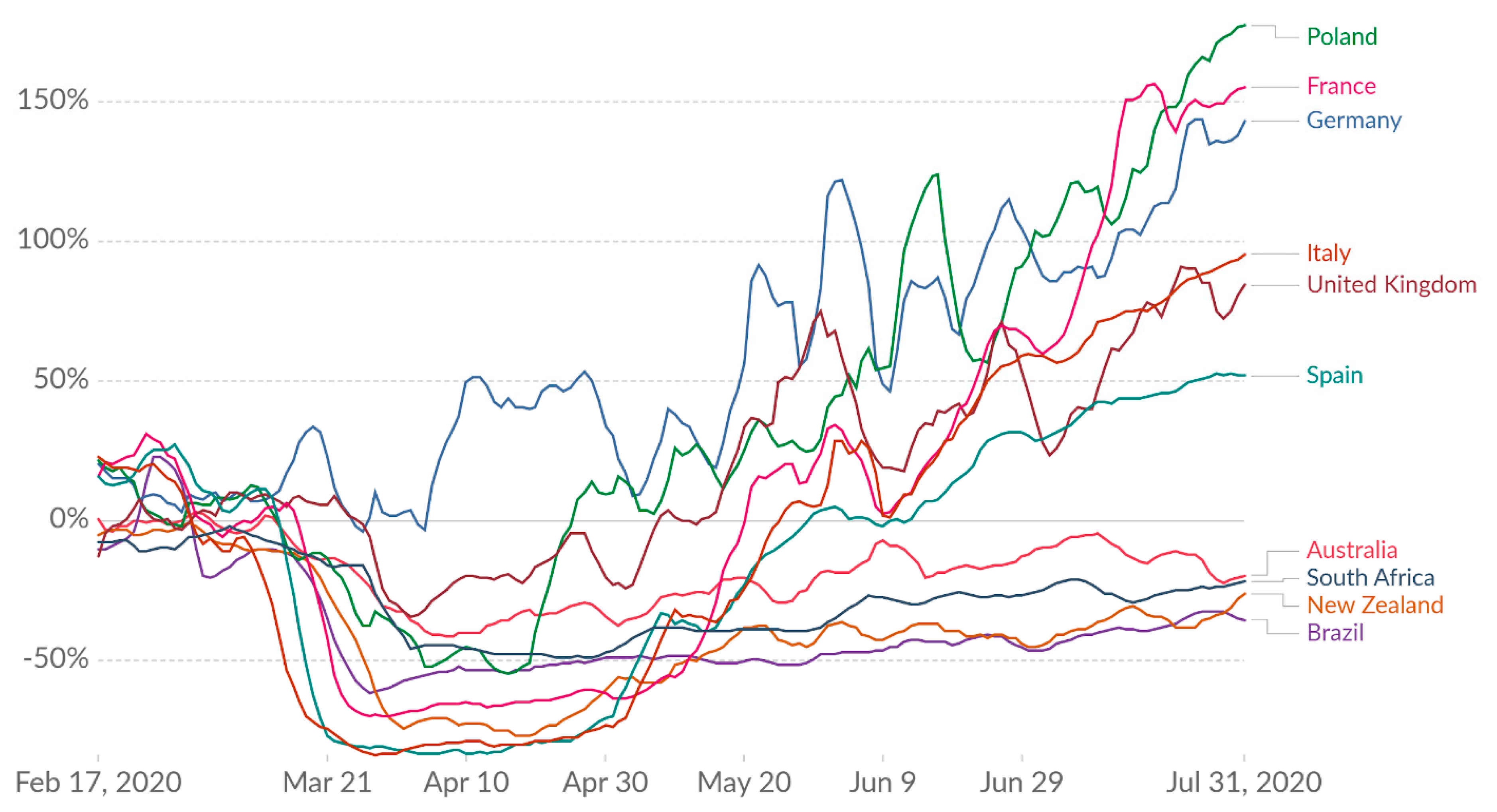
| Miramar Park | Polińskiego Park | |
|---|---|---|
| size | 5.18 ha (4.42 ha open “greens”, tennis courts and preschool area + 0.76 bowling club). Functional, open, accessible area = ~3.9 ha | 5.52 ha (3.9 ha functional area) |
| year established | ~1906 * | 1962 |
| facilities | Bowling club (building and 3 bowling greens); tennis club (building and 6 courts); preschool with a small garden; large central lawn (team sports field) | Multifunctional sports field (football, basketball, volleyball, tennis); children’s playground; outdoor gym; paddock for dogs; artificial hill; fountain; paved square; monuments; service pavilions (currently not used). |
| location | Miramar, eastern suburb of Wellington. Residential area of single-family detached houses. | Grochów (Praga-South), eastern inner-city area of Warsaw. Residential area: mixed, predominantly multi-family housing. |
| population (park’s “neighbourhood”) | 3318 (in 2018), area: 104 ha, 31.9 pers/ha population density. | ~20,000 (in 2018), area: 160 ha, 125 pers/ha population density. |
| social structure (park’s ‘neighbourhood’) | Mixed, but undergoing rapid gentrification and changing towards domination of creative class. Median property sales price grew 39% over the last 5 years. Median income is slightly lower than in the entire city (34,000 NZD a year as compared to 41,800 NZD for Wellington City). | Mixed, undergoes modest gentrification (visible in physical changes of the built environment as well as in the increase of average real estate prices—below 7000 PLN in 2010, and even 11,000 PLN in 2019 per 1 square meter). Median income lower than in the entire city (belongs to the two lowest quartiles). Gini coefficient for income below 0.44 (average for Warsaw = 0.48). |
| Respondent | Date | Gender | Age | Profession | Type of User |
|---|---|---|---|---|---|
| WAR1 | 25 May 2020 | F | 34 | Corporate employee | Parent |
| WAR2 | 26 May 2020 | F | 29 | Corporate employee | Dog owner |
| WAR3 | 27 May 2020 | F | 66 | Retired | Senior |
| WAR4 | 28 May 2020 | M | 21 | Low-skilled worker (currently unemployed) | Parent (precarious) |
| WAR5 | 29 May 2020 | M | 12 (both) | Students | Youth |
| WEL1 | 7 August 2020 | F | 37 | Teacher | Parent |
| WEL2 | 7 August 2020 | F | 53 | Corporate employee | Dog owner |
| WEL3 | 9 December 2020 | F | 70 | Retired | Senior |
| WEL4 | 9 December 2020 | M | 71 | Retired | Senior |
| WEL5 | 9 December 2020 | M | 13 | Student | Youth |
| WEL6 | 9 December 2020 | M | 11 | Student | Youth |
| Polińskiego Park | Miramar Park | ||
|---|---|---|---|
| Pre-Pandemic + Designed | Pandemic + Designed | Pre-pandemic + Designed | Pandemic + Designed |
| Benches Children’s playground Local festivals Local political events Outdoor gym Paddock for dogs Running Sports field Strolling | Benches Paddock for dogs Running Strolling | Benches Team sports (football, cricket) Lawn bowling Tennis courts | Benches |
| Pre-Pandemic + Non Designed | Pandemic + Non Designed | Pre-Pandemic + Non Designed | Pandemic + Non Designed |
| Alcohol drinking Children’s games Family/friends picnics Riding a bike, skateboard or scooter Dog walking Kites/drones flying | Alcohol drinking Children’s games Family/friends picnics Outdoor gym Riding a bike, skateboard or scooter Dog walking Kites/drones flying | Dog walking Family/friends picnics Running Strolling Individual/”bubble” exercise Riding a bike, skateboard or scooter Kites/drones flying Meetings with friends, social interactions | Dog walking Family/”bubble” picnics Individual/”bubble” exercise Running Strolling Riding a bike, skateboard or scooter Climbing trees Kites/drones flying |
Publisher’s Note: MDPI stays neutral with regard to jurisdictional claims in published maps and institutional affiliations. |
© 2021 by the authors. Licensee MDPI, Basel, Switzerland. This article is an open access article distributed under the terms and conditions of the Creative Commons Attribution (CC BY) license (http://creativecommons.org/licenses/by/4.0/).
Share and Cite
Herman, K.; Drozda, Ł. Green Infrastructure in the Time of Social Distancing: Urban Policy and the Tactical Pandemic Urbanism. Sustainability 2021, 13, 1632. https://doi.org/10.3390/su13041632
Herman K, Drozda Ł. Green Infrastructure in the Time of Social Distancing: Urban Policy and the Tactical Pandemic Urbanism. Sustainability. 2021; 13(4):1632. https://doi.org/10.3390/su13041632
Chicago/Turabian StyleHerman, Krzysztof, and Łukasz Drozda. 2021. "Green Infrastructure in the Time of Social Distancing: Urban Policy and the Tactical Pandemic Urbanism" Sustainability 13, no. 4: 1632. https://doi.org/10.3390/su13041632
APA StyleHerman, K., & Drozda, Ł. (2021). Green Infrastructure in the Time of Social Distancing: Urban Policy and the Tactical Pandemic Urbanism. Sustainability, 13(4), 1632. https://doi.org/10.3390/su13041632







